Terri Cecere remembers the moment her heart transplant became very real to her. It was a sensation she hadn't felt – in years.
“I was sitting up in the chair in my hospital room, and I could feel my heartbeat – even through the blankets," Terri says. “Prior to the surgery, my old heart was so weak that I could not feel it beating. And when I felt that for the very first time, I was like, oh my gosh, this is amazing!"
In November 2022, Terri became the very first in a growing number of patients to receive a new heart through
The Christ Hospital Heart Transplant program.
It was an operation she hadn't been expecting. She felt healthy and had been successfully managing heart disease for almost two decades. Her numbers told a very different story – pointing to rapidly advancing heart failure.
But to truly understand Terri's journey to heart transplant, you need to travel back to the mid-1970s, when she was just being courted by her future husband, George. It was around that time that she faced down another devastating disease – cancer.
A Springsteen concert – and a suspicious lump
George still remembers the day in 1976 when he met Terri in Wapakoneta, Ohio. “I was working at a restaurant as a grill cook, and her mom worked there as a waitress," George says. “Her mom brought her in to say hi, and I looked out at her and said, hmm, cute!"
Terri and George started dating that summer. Even though George was heading off to college that fall, they agreed to keep in touch. “She came up to me and said, would you write to me while you're at Miami University," George says. “We started writing back and forth."
The connection between Terri and George stuck. Writing turned to visits in Oxford, Ohio. It was there on the Miami campus that Terri and George went to their very first Bruce Springsteen concert together at Millett Hall. Tickets to see The Boss were just $6 back then.
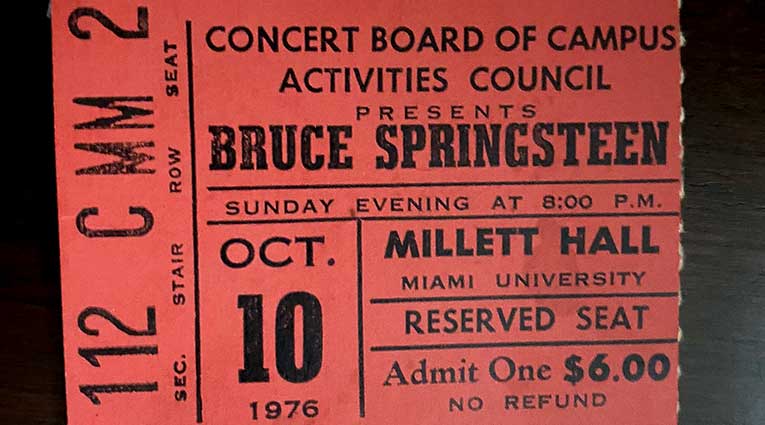
It was around that time when Terri noticed something strange – a lump on the back of her head. “I was scheduled for a biopsy, and that's when they discovered I had cancer," Terri says. “Initially, the labs came back that it was malignant melanoma. That doesn't have a very good outcome."
The odd thing about Terri's cancer was no one could find a source for malignant melanoma – so her doctors in Lima didn't know how to treat it. Her surgeon referred her to a hematologist-oncologist in Columbus for a second opinion.
“He said I don't think it's malignant melanoma, I think it's non-Hodgkin's lymphoma because of where your tumors are," Terri says. “He said we're going to treat it, and if that's what it is, we'll find out overnight. Your tumors will start to shrink."
The tumors did shrink. She was initially scheduled for eight rounds of treatment. Two more were added to be on the safe side in getting rid of the cancer.
“We did the final two, and he said we can't do any more because one of the medications could cause irreversible heart or kidney damage," Terri says.
“Terri always wondered how they knew exactly how much was going to be okay," George says. “Cardiologists today follow that a whole lot closer, but that was 46 years ago, so it was kind of a guess."
“I went back for five years of follow-up, and they never said the words you are in remission," Terri says. “They said you can
consider yourself in remission, and at that point there were no more follow-ups. There were no tests or anything with my heart or kidneys after that."
“If I'm doing fine, why do I feel so bad?"
With cancer in the rear-view mirror, life seemed full of possibilities for the young couple. George transferred to Ohio Northern University in 1978. That same year, George and Terri got married. They had two children, Joanna in 1980, and Nicholas in 1982.
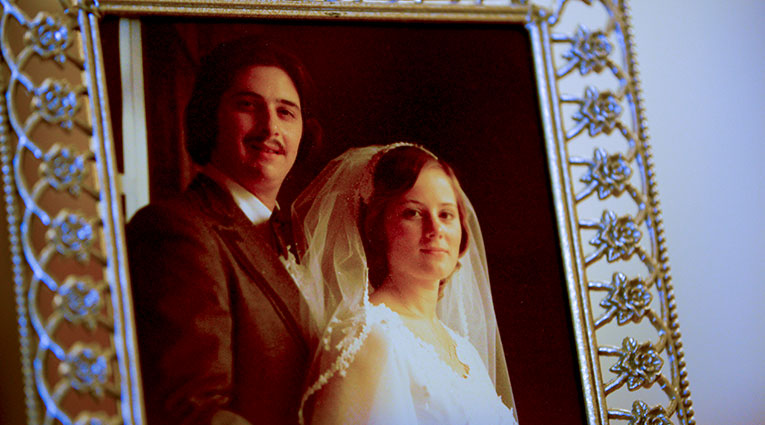
“We kind of went on with life, you know – the normal," George says. Terri and George eventually moved to Lexington, Ky. Cancer and complications, for the most part, were a distant memory. “We didn't really think about it much. It wasn't until the first diagnosis of heart failure in 2004."
“I was diagnosed with cardiomyopathy. I had all the classic symptoms of heart failure," Terri says. Some studies have shown cancer survivors like Terri
can have twice the risk of developing heart failure compared to those who never had cancer.
“The heart failure treatment I had then was mostly medication, and it helped for two years," Terri says. At a follow-up appointment Terri was told she was doing fine, but wondered, “If I'm doing fine, why do I feel so bad?"
It was time again for a second opinion. She found a doctor in Cincinnati with more experience in
treating heart failure. She turned to her sister, a registered nurse, and her cousin, an RN and insurance claims evaluator, to write up her story to the doctor in an email.
“Within a few days, the doctor responded. She was interested in the possibility that the [cancer] medication I had taken caused heart damage this much further down the road," Terri says.
Terri made trips up and down I-75 – from Lexington to Cincinnati and back – just to get better heart care. “She got me on the right medications and implanted a defibrillator for protection," Terri says.
Terri also met a new doctor,
Thomas O'Brien, MD, who was just finishing up his cardiology fellowship, and would play an increasingly important role in keeping Terri alive.
Terri's primary cardiologist was moving on to another hospital, and Dr. O'Brien was about to join The Christ Hospital Health Network. “I said can I follow you? And that's where I've been with him for almost 17 years," Terri says.
“We felt the confidence and comfort because of his manner with us, because of his knowledge, and the way he shared with us how he felt Terri's progress might go," George says. “When we decided to move back to Ohio in 2019, one of the questions we had for Dr. O'Brien was whether he was going to stay. It was a deciding factor on whether to move back to this part of Ohio so we could be closer to The Christ Hospital Liberty Campus where we see Dr. O'Brien."
Riding a wave that was about to crash
Year after year, Terri and George always seemed to be a step ahead of her heart failure.
“The two of them were always very engaged and trying to do everything right so she could stay healthy," Dr. O'Brien recalls. “We've been able to stay ahead of the current."
It was almost like riding a wave of innovation. Dr. O'Brien always seemed to have access to a promising treatment that would help Terri at the perfect moment.
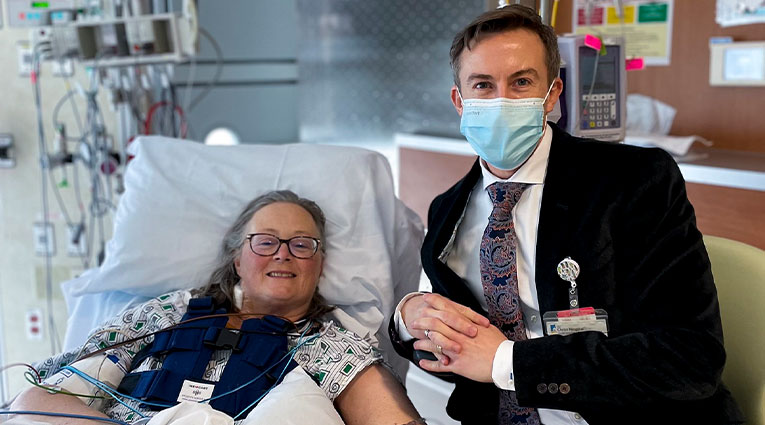
“Something new comes on board, looks like she needs it. We add the new thing, and she stays healthy for a while," Dr. O'Brien says. “Whatever new thing has come on the scene as a treatment benefit for heart failure patients, it worked out for her timing-wise."
Medications. Biventricular resynchronization. Pacemakers. Defibrillators. Whatever Terri needed, The Christ Hospital had it for her. “That pretty much saw me through for 17 years," Terri says. “We knew you don't live with heart failure forever. Eventually you hit bottom, but we didn't think we were there yet."
Everything worked perfectly until – Terri's wave suddenly looked like it was about to crash.
“She stayed ahead of the curve until about a year ago when she started to come down in her function," Dr. O'Brien says. “She couldn't do the things she wanted to do and enjoy at home. That's when we knew she had to do something more."
“He called me into the office and said I think we're in advanced heart failure now," Terri says. “I wasn't expecting that. I was expecting some new medicine or device to help me with the next steps."
Terri was down to one final option: a heart transplant. After traveling decades ago to Columbus for cancer treatment – and to Cincinnati for heart care – Terri and George were left wondering, where do we go now for a heart transplant?
We have one more innovation for you…
The wave of innovation that Terri experienced at The Christ Hospital was about to lift her up once more. During a meeting with
advanced heart failure specialist Gregory Egnaczyk, MD, in October 2022, he mentioned that the hospital would be starting a heart transplant program soon. The doctors were just waiting on final approval.
Three days later, that approval was official.
“I remember seeing it on social media," George says. “I sent it to our kids. If mom needs a transplant, we can do it right here. It was a relief. Part of the concern about transplant was where will we go and how will we deal with that?"
The wave was rolling forward for Terri once again.
As timely as the innovation was, a heart transplant is still a big decision. Terri and George did their research – starting with learning more about heart transplant
medical director Geetha Bhat, MD, and
surgical director Robert Dowling, MD, who also serves as the Chris and Trey Heekin Family Endowed Chair for Cardiac Transplantation.
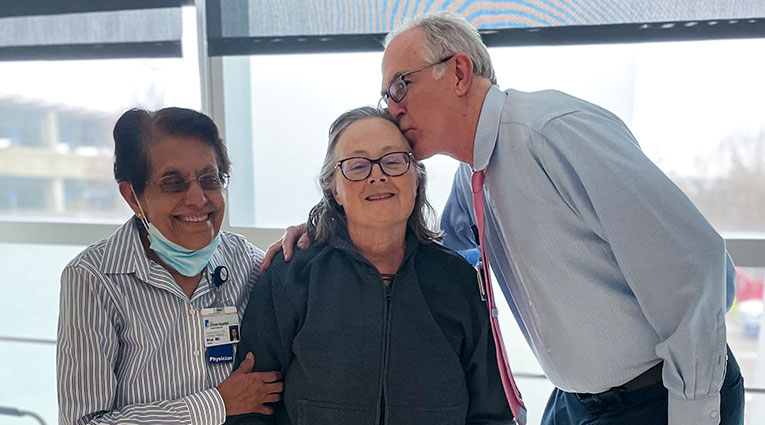
“We understood they had been working together for a lot of years, and that Dr. Dowling had some firsts in terms of cardiac surgery," George says. “We have a family friend whose son is a heart transplant team member in Milwaukee, and he had heard of Dr. Bhat and Dr. Dowling, so that gave even more credibility."
Gaining confidence and resolve, the Ceceres decided to meet the team. “We connected right away," Terri says. “Dr. Bhat answered all our questions and made us feel that we were in the right place. Dr. Dowling doesn't miss a beat."
“We spend a lot of time talking about prognostic indicators – things that predict if you're going to be okay for a while. Hers were leaning towards not," Dr. Dowling says. At the time, Terri said she still felt fine, but her stats told a different story.
“I looked at her labs and X-rays and expected to see this incredibly sick-looking patient," Dr. Dowling says. “We need to get serious, because all these things indicate to me that you're at serious risk of getting pretty sick, pretty quick."
The bottom did fall out, and Terri ended up in the hospital. “I met her in the intensive care unit where she was hospitalized with very severe heart failure," Dr. Bhat says. “It's difficult for your heart to compensate, so your blood pressure goes down. It's very difficult to even walk a few steps."
Terri was put through a battery of tests to see if she would qualify for a heart transplant. With some additional care to lower her pulmonary hypertension, she made it on to the transplant list.
George and Terri made peace with the decision, but not until after a very emotional conversation. “We were having coffee one morning and she said, I want to talk about this. Here's what I expect if things don't go well," George said. “We shed a lot of tears, then it was out of the way."
“I can't control things, so I just let it go," Terri says. “I was able to help with my breathing if I started to get nervous. I'm surprised I was as calm as I was," she says with a laugh. “We call it Zen moments."
There wasn't even much time for Terri or George to be nervous. Terri was placed on the transplant list on November 1. The match came – just a few days later.
Transplant day brings renewed optimism
November 5 was a particularly windy day in Cincinnati. Terri's new heart arrived at Lunken Airport. It was supposed to come to The Christ Hospital by helicopter, but the chopper was grounded by the weather. So, the transport was done by ambulance instead.
“They came in and said we'd be delayed, but Terri's response was that the donor's family was going through worse than we are," George said, recognizing that Terri's transplant was only possible because another family made the gift of life. “Throughout the evening it was her spirit, her inspiration that kept me calm."
Once the operation started, hours would pass where all George could do – was wait. “I didn't sleep. I was certainly nervous."
George's first good sign came when he looked at the patient portal, where he could see the surgery's progress.
“We had gotten pretty good at looking at clinical reports over the years. I knew Terri's ejection fraction (a measure of blood pumping out of the heart) had been down in the 15 range, and normal is 55 to 60," George said. “I got the first echo and saw it was between 55 and 60, and it literally brought tears to my eyes. It was that a profound moment where I thought, oh my God, she has a new heart."
“It was around 4:30 in the morning when Dr. Dowling and the whole team came in, and they were very upbeat and enthusiastic," George says. “It just felt like relief."
“When we first saw Terri, they prepped us and said she's going to have all the tubes and ventilator, and she's basically going to be out of it," George recalls. “I came in and held her hand and kissed her on the cheek, and her eyes kind of fluttered. From that moment on, I felt like this is going to be okay."
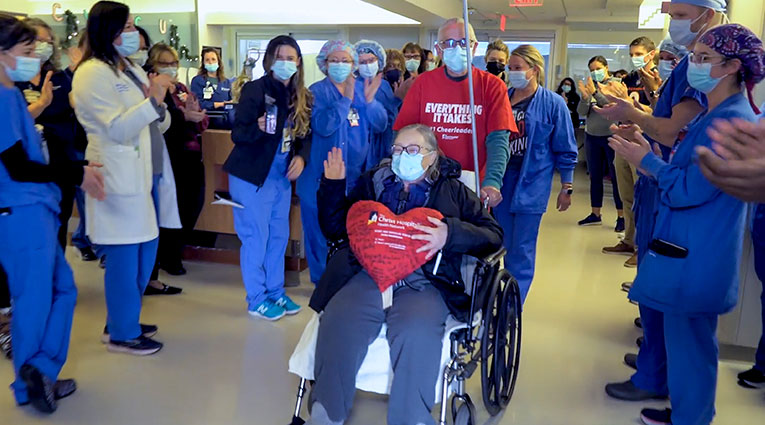
Terri was eventually able to head home from the hospital. On New Year's Eve, there was a set-back when paramedics had to be called to the house. Her heart rate and blood oxygen levels dropped.
The paramedics knew exactly how to respond. “Because one of The Christ Hospital team members, Joseph Hughes, came here and spent three days meeting with local paramedics, telling them some of the specific things that needed to be handled if there was an emergency," George says.
The crews rushed Terri back to The Christ Hospital – and it was quickly determined that her new heart was beating too slowly. And wouldn't you know it – but another innovation was there for Terri: a leadless pacemaker, about the size of a vitamin, that would be implanted inside her new heart to keep it in rhythm.
“Another lifesaving innovation," George says. “Those even continued since the surgery."
Time to walk in the sun
After weeks in the hospital, and months in recovery, Terri and George finally got back to doing something that seemed out of reach for a long time – simply leading a normal life again.
“One day my heart is ready to give up and stop, and there's nothing more we can do for it – and then the next day you've got this new heart beating inside you," Terri says. “it's just – it was just amazing."
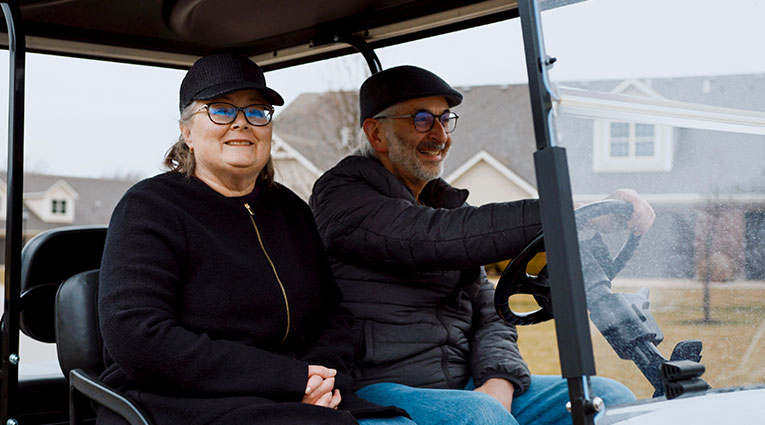
“It's great to sit back and reflect about the next sunrise we'll be able to see, or the next time we'll be able to go to a Springsteen concert, or the next time we'll be able to go out to California where we love to spend time," George says. “All because somebody was willing to make a decision to donate, and because The Christ Hospital team, and what Terri called providence, led us to this point."
And speaking of Springsteen concerts, Terri and George have taken in quite a few since that date at Miami University back in 1976. Nearly three dozen, in fact. The same year their daughter Joanna was born, Springsteen released the song “Two Hearts" on his album
The River. That's now the license plate on George's car.

Joanna even had a poster made for her parents with lyrics from the Springsteen classic, “Born to Run."
“Oh, someday, girl, I don't know when
We're gonna get to that place
Where we really wanna go and we'll walk in the sun
But 'til then, tramps like us
Baby, we were born to run."
“When I retired, I said it's time to walk in the sun," George says. “So enjoying our retirement years – we haven't been able to do it yet, but it's something we're looking forward to."
“She rose to the occasion, and we are so proud of her," Dr. Dowling says of Terri. “The amazing thing about her – she was resilient and strong. If I'm ever in that situation, I hope I can be as tough as she is."
And now Terri and George are both spreading the word about the importance of organ donation – encouraging others to register to become organ donors.
“Terri and I have always been organ donors. It's just something that we thought was the right thing to do," George says.
“I'm grateful for this gift, but I know what had to happen to somebody in order for me to get it," Terri says. “Someone else is able to continue living, and it is the greatest gift that anybody can give or receive. So I encourage all people to become organ donors. You just never know when you can help somebody else."